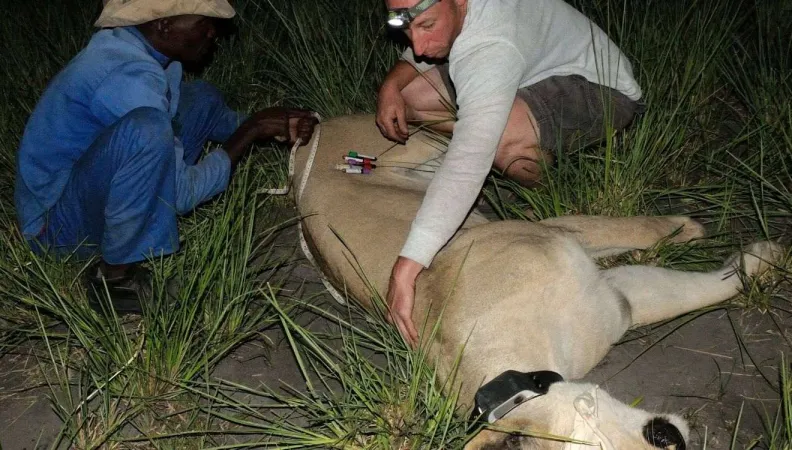Share the page

The Food and Agriculture Organisation of the United Nations (FAO) and Agence Française de Développement (AFD) will support the development of community conservancies in the Kavango-Zambezi Transfrontier Conservation Area (KaZa TFCA) in Namibia and Botswana.
The Government of Namibia, the FAO and Agence Française de Développement met today in Windhoek for the official project signing ceremony to kick off the implementation of the Namibia component of the transboundary Community Conservancy Sustainable Wildlife Management (SWM) project. The activities in Namibia will form part of a EUR 3.5 million project financed by AFD to improve sustainable wildlife management and food security in Namibia and Botswana.
Southern Africa's Kavango-Zambezi (KaZa) Transfrontier Conservation Area is the world's largest terrestrial transfrontier conservation area and a biodiversity-rich functional ecosystem under the management of the governments of Angola, Botswana, Namibia, Zambia and Zimbabwe and of their local communities. KaZa experiences large-scale migrations of megafauna each year. This affects elephants in particular, as 50 % of the total population of African elephants can be found in this region. However, the area is also home to poor rural communities whose livelihoods depend on agriculture, fishing and hunting and are not always able to meet their basic needs.
Under the Sustainable Wildlife Management Programme, the new project will partner with the governments of Namibia and Botswana to address threats from unsustainable levels of wildlife hunting, closure of habitats, and fragmentation, which prevent animals from reaching the resources they need to survive, as well as poaching of animals as a result of human-wildlife conflicts. The project also aims to increase the resilience of the communities faced with erratic rainfall and frequent droughts.
"The focus of the project is to benefit both the wildlife and ecosystems in the Transfrontier Conservation Area and the resilience of local communities that rely on them, at least in part, for food and income," said Farayi Zimudzi, FAO Representative in Namibia.
Community conservancies
The project will focus on supporting the development of a network of community conservancies and community-based organizations that help manage community-owned land to ensure the conservation and sustainable use of natural resources for the benefit of local livelihoods. Namibia already has a network of 86 community conservancies, which collectively cover 20 % of the country and are home to nearly 230,000 people. "This project aims to establish an effective network of community conservancies since they have proven to be a powerful means to combat rural poverty," said Gilles Kleitz, Director of the AFD Ecological Transition and Natural Resources Department. "In Namibia, for instance, conservancies contributed to more than USD 10 million in benefits such as income, employment remuneration, and payments in kind, for example meat, to conservancy members in 2018. The overall economic contributions from these benefits amounted to more than USD 62 million, including the creation of over 5,300 jobs from conservancy related operations and enterprises."
Further reading: €1 Billion for Biodiversity
In Namibia, the project will be implemented with the support of World Wildlife Fund (WWF) Namibia. The project sites include 12 community conservancies in the Khaudum-Ngamiland and Kwandu wildlife dispersal areas, as well as the Kyaramacan Association in Bwabwata National Park. Together, these sites will foster ecological connectivity throughout the KAZA landscape. The project will also contribute to create policies aimed at fostering the development of community conservancies, sustainable hunting, wildlife conservation and enhanced institutional and legal frameworks needed to implement these policies.
The Sustainable Wildlife Management Programme is already promoting a similar approach in Zambia and Zimbabwe. The project will also aim to share successful models and practices among sites and to promote them to policy makers and public and private investors.
About the Sustainable Wildlife Management Programme
The Sustainable Wildlife Management Programme is an Organisation of African, Caribbean and Pacific States (OACPS) initiative, funded by the European Union with co-funding from the French Facility for Global Environment (FFEM), and now the French Development Agency (AFD). It develops innovative, collaborative and scalable new approaches to conserve wild animals and protect ecosystems, while at the same time improving the livelihoods of indigenous peoples and rural communities who depend on these resources. The SWM Programme is being implemented by FAO, the French Agricultural Research Centre for International Development (CIRAD), the Center for International Forestry Research (CIFOR) and the Wildlife Conservation Society (WCS).
